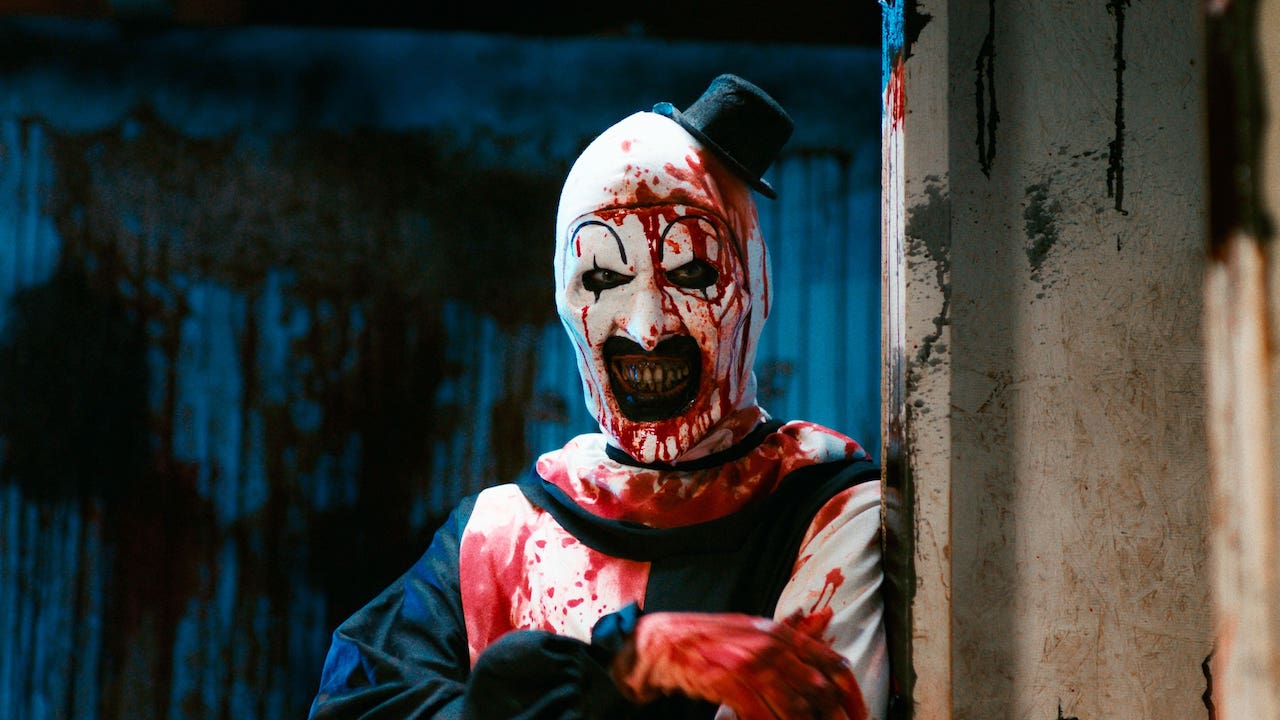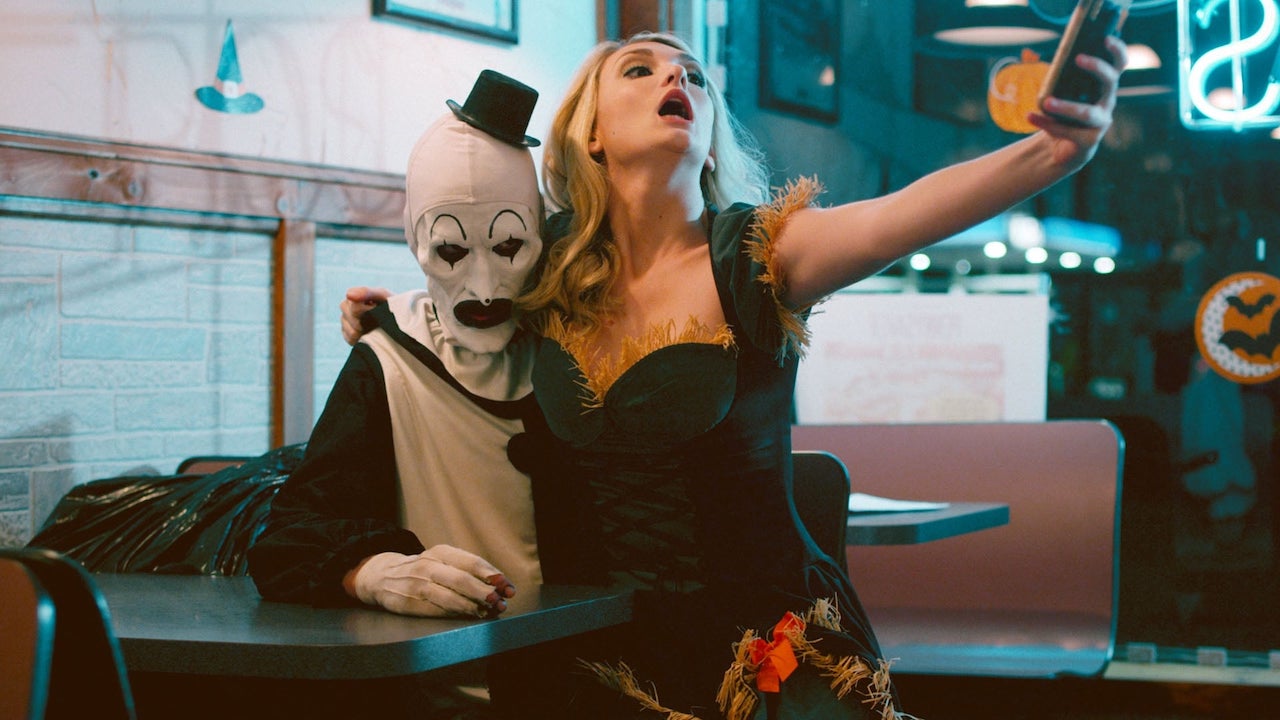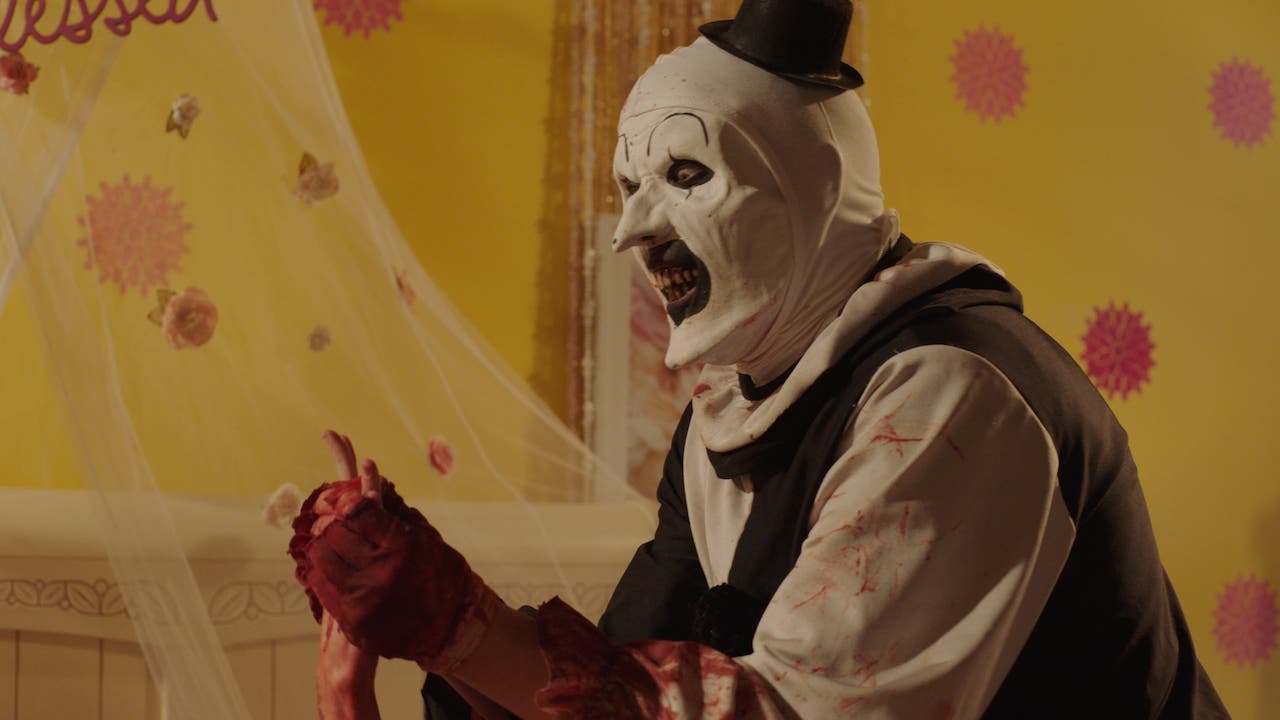The revolting Terrifier films redefine senseless violence on screen

If you can’t handle the sight of blood, please turn away now: the hugely successful indie horror franchise Terrifier is 100% not for you. Everyone else, follow Eliza Janssen along on a journey of peeling back exactly what makes these films succeed—or fail.
Terrifier 2
Isn’t it lovely to see a tasteful little indie film grab an audience’s attention, in this era of cinematic universe bloat and ceaseless sequels? Made on a shoestring budget of just $35k, Damien Leone’s Terrifier relied upon a few tried-but-true commercial horror concepts to quickly become a midnight movie fave.
The first weapon in the Terrifier series’ arsenal is a graphic, iconic villain: David Howard Thornton’s wordless performance as Art the Clown. In a striking black-and-white getup that looks like a 1930s cartoon come nightmarishly to life, he’s instantly memorable on everything from the film’s posters to fan tattoos. Secondly, the franchise puts its extreme violence front and centre, with disgusted reviews and vomiting audiences proudly presented as seals of genre approval in Terrifier marketing content. Leone claims to have never expected the gore-first approach to pay off: “to see it snowballing, the word of mouth growing, people getting sick and fainting and it really taking off…I did not expect it to make this kind of splash or to even play in theatres.”
But look below those attention-grabbing elements to the stories within, and you’ll find…um…give me a minute. Hm. What is there to say about Terrifier and Terrifier 2 beyond its most stomach-churning, cult-classic-crowning selling points?
Horror nerd streaming service Shudder recently made both Terrifier films available to subscribers worldwide. As with viral horror experiment Skinamarink, it’s really the perfect, accessible environment for this word-of-mouth phenomenon. Harkening back to the video tape era of uncensored, buzz-inducing scary movies, curious horror fans might’ve heard rumours about the most extreme Art the Clown kills long before they were ever able to sit down in front of the films themselves. The plot of Terrifier is as basic as can be beyond its twisty cold open, with two Halloween partygoers getting chased around a derelict building by the grinning Art. No gorehound fanboy is going to breathlessly tell you about the film’s insightful themes, or tightly-structured screenplay. Nah, they’ll be all like: “so 20 minutes in, Art has this girl chained up, upside down, naked. And then he takes out a chainsaw…”
There are no loveable final girls to root for here: only whimpering vessels of pain. The film’s defining moment comes when Leone pulls out the rug from under us and kills off bland decoy protagonist Tara (Jenna Kanell), leaving her sister Vicky (Samantha Scaffidi) to be Art’s ultimate, most ‘art’-fully mutilated victim. It’s an impish, dread-inducing moment that kinda breaks genre rules. After running around after each other for an hour with knives and wooden planks, Tara looks like she might finally victor over the demonic clown when he suddenly deadpans, whips out a gun, and blows her away. It’s like seeing Wile E. Coyote give up the act and just outright eat the Roadrunner—or watching a fed-up Harry Potter gun down Voldemort with an AK47. The cat-and-mouse game is fun and all, but when it comes down to it, Art must win.

The clown’s senseless obsession with causing people pain might be taking its cues from John Carpenter’s seminal Halloween, giving us a bad guy intended to be all the more terrifying for his utter lack of motivation. (In Carpenter’s original film, Michael Myers was credited only as ‘The Shape’: an inhuman, ambitious force of darkness.) Then again, maybe Art is something closer to the maniacal, bloodthirsty style of Evil Dead’s Deadites, or Joe Dante’s Gremlins: otherworldly baddies who get a visceral sense of joy from seeing humans suffer, often cackling madly while they’re on the job. Of course Art never lets out a giggle—even when he’s ‘screaming’ in agony, it’s hilariously mimed. One scene in Terrifier sees a homeless woman trying to soothe the killer, and he briefly seems to appreciate a mother’s touch. But lest you think we’re getting anywhere in understanding Art’s past or purpose, she’s soon turned into a scalp-wig and flesh-dress for him to romp around in. Never mind, then…
If Terrifier made a name for its director and gleefully awful main character, Terrifier 2 confirmed the saga as a low-budget revolution. Its crowd-funded budget of $250k and an indulgent runtime of 140 minutes promised horror addicts that they were in for something bigger, better and perhaps more legitimate than the pulpy original film. By some metrics, we can say that Terrifier 2 certainly delivered—it earned a stunning $15 million dollars and has paved the way for a further two instalments!—but the sequel’s expansiveness also exposed some of the greater problems lying below that flashier, blood-slicked surface.

In what’s obviously a direct response to the lacking female heroes of Terrifier, Terrifier 2 introduces us to badass cosplaying teen Sienna (Lauren LaVera), Leone’s “favourite character” that he’s ever written. In a ridiculously long title sequence, we watch her working on a sexy angel costume for an upcoming Halloween party…and then taking a steamy shower, camera lingering over her adolescent body. Leone felt the need to create a hero that could rival the villainous Art’s popularity, a virtuous Batman to Terrifier’s monochrome Joker, and as Sienna’s friends and family fall victim to the resurrected clown, she’s clearly the coolest, hottest, bravest character around to step up to the plate.
Once you’re about halfway through Terrifier 2, though, the film’s obnoxiously gory centrepiece scene makes it very difficult to care about the mythic lore surrounding Art and Sienna’s nemesis-hero dynamic. It’s all any genre film festival audience could talk about, and it completely embodies (disembodies?) the Terrifier franchise’s raison d’être. Sienna’s bestie Allie (Casey Harnett) is stalked, stabbed, de-limbed, scalped, and finally flayed by Art, who leaves her alone and screaming in her room for a moment before returning with a big bag of salt for those gnarly wounds. The aim is pure shock value, and even a little comedy at just how horrifically delayed the teen’s merciful death can be. Art even uses the kid and her mum’s decapitated heads to serve trick-or-treaters candy.

Let me be clear: I attach no negative connotations to the words “senseless” and “meaningless” when describing the tone of horror in the Terrifier films. All art is, to some extent, pretty meaningless unless creatives and audiences engage with it, and these films, low-brow, low-budget and unsophisticated as they are, have certainly garnered a huge reaction. The issue, then, is that the Terrifier franchise is seemingly striving to be more ambitious, promising that future chapters will reveal more about “Art’s background and motives”.
Why? Art has transcended beyond the simple, splashy films in which he stars not because of deeper questions as to who he is, but merely through what he does and how he looks—the static, vaudeville smile he returns to after doing something gut-churningly horrible. He even made his way into Pete Davidson’s prestige TV series Bupkis, basically just standing there and adding a nasty flavour to the comedy in a way that didn’t require uninitiated viewers to be familiar with his narrative at all.
Performer David Howard Thornton says that beyond slasher jester Freddy Krueger, his influences for playing Art are all based in the world of comedy. We’re talking Harpo Marx, the Grinch, even Thornton’s late friend Stefan Karl who played kiddie show bad guy Robbie Rotten. It feels like a mistake for Terrifier 2, and any oncoming Art killfests, to dwell in the world of self-serious fantasy lore-building, or trying to make us care too much about a Laurie Strode-esque force of goodness. In this blood-soaked series, plot and purpose are a waste of time when we could be watching Art chop off a guy’s still-urinating dick instead. Worldbuilding? Traumatic backstories? Characters you care about? Now that’s really senseless.



















